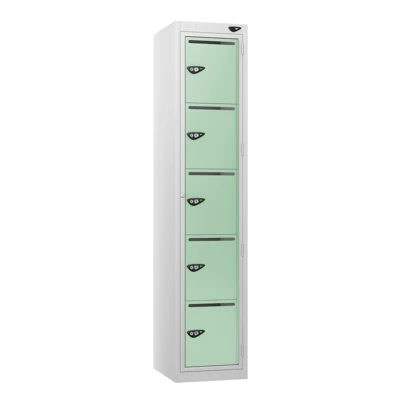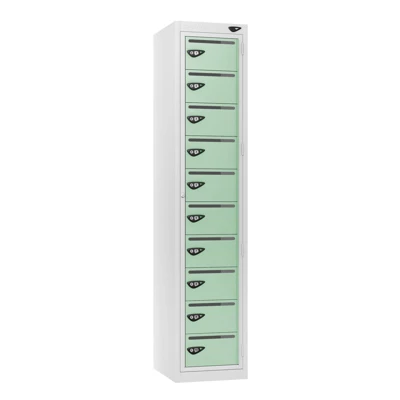Postage Lockers: Large facilities face a growing challenge. Post volumes continue to increase. Traditional mail rooms struggle to cope. However, postage lockers offer an innovative solution that transforms how organisations handle their mail and parcels.

Management Challenge
Today’s large facilities receive unprecedented amounts of post. Corporate headquarters, universities, hospitals, and residential complexes all experience this surge. Moreover, the rise of online shopping has dramatically increased parcel deliveries.
Traditional post rooms create bottlenecks. Staff spend hours sorting mail manually. Recipients wait in long queues. Furthermore, security concerns mount as valuable packages accumulate in unsecured areas.
Consequently, facility managers seek smarter alternatives. Postage lockers emerge as the perfect solution. They streamline operations whilst enhancing security and convenience.
What Are Postage Lockers?
Postage lockers are automated storage systems designed for mail and parcel management. These secure, intelligent units feature multiple compartments of varying sizes. Additionally, they incorporate advanced technology to automate the entire post collection process.
Each locker connects to a central management system. Recipients receive notifications when items arrive. Subsequently, they can collect their post at any time using secure access codes or key cards.
The system works seamlessly. Postal workers deposit items into appropriate compartments. The system then sends automatic notifications to recipients. Finally, recipients collect their items using personalised access methods.
Key Benefits of Postage Lockers in Large Facilities
Enhanced Security
Security represents the primary advantage of postage lockers. Each compartment locks automatically after deposit. Only authorised recipients can access their items. Therefore, the risk of theft or loss reduces dramatically.
Furthermore, the system maintains detailed audit trails. Every access gets recorded with timestamps and user identification. This transparency provides valuable accountability for valuable items.
Improved Efficiency
Postage lockers eliminate traditional mail room bottlenecks. Staff no longer need to sort post manually. Recipients collect items independently. Consequently, administrative overhead decreases significantly.
The 24/7 availability proves particularly valuable. Recipients access their post outside normal office hours. This flexibility reduces disruption to daily operations.
Cost Reduction
Initially, postage lockers require investment. However, they deliver substantial long-term savings. Reduced staffing requirements lower operational costs. Additionally, decreased theft and loss prevent financial losses.
Space utilisation improves dramatically. Compact locker systems require less floor space than traditional mail rooms. Therefore, facilities can repurpose valuable real estate for other uses.
Better User Experience
Recipients appreciate the convenience postage lockers provide. No more queuing during busy periods. No more missed deliveries due to absence. Instead, they enjoy 24/7 access to their post.
The automated notification system keeps everyone informed. SMS messages, emails, or app notifications alert recipients immediately. Thus, important items never go unnoticed.
Types of Postage Lockers for Different Facilities
Corporate Office Lockers
Corporate environments benefit enormously from postage lockers. These systems handle everything from letters to large parcels. Integration with employee ID systems ensures seamless access.
Smart features enhance the corporate experience. Analytics provide insights into post volumes and collection patterns. Additionally, integration with building management systems improves overall security.
University Campus Lockers
Universities face unique post management challenges. Student accommodation, academic departments, and administrative offices all require different solutions. Postage lockers adapt to these diverse needs perfectly.
Student-focused features prove particularly valuable. Mobile app integration appeals to tech-savvy users. Furthermore, flexible sizing accommodates everything from textbooks to care packages from home.
Healthcare Facility Lockers
Hospitals and medical centres handle sensitive materials regularly. Postage lockers provide the security these items demand. Temperature-controlled options protect pharmaceutical deliveries.
Integration with hospital systems ensures compliance with healthcare regulations. Audit trails support governance requirements. Moreover, 24/7 access accommodates shift work patterns common in healthcare.
Residential Complex Lockers
Apartment buildings and housing developments increasingly adopt postage lockers. These systems eliminate the need for concierge services. Residents enjoy unprecedented convenience and security.
Visitor management features add extra value. Temporary access codes allow secure delivery to guests. This flexibility enhances the overall residential experience.
Implementation Strategies for Large Facilities
Assessment and Planning
Successful implementation begins with thorough assessment. Facility managers must evaluate current post volumes and patterns. This analysis informs system sizing and configuration decisions.
Location planning proves equally important. High-traffic areas ensure easy access. However, security considerations may favour more controlled locations. Therefore, balancing accessibility with security becomes crucial.
Technology Integration
Modern postage lockers integrate with existing facility systems seamlessly. Access control systems connect with employee databases. Building management systems share security protocols.
Furthermore, integration with delivery companies streamlines operations. Major carriers increasingly support direct locker delivery. This collaboration reduces handling requirements and improves efficiency.
Staff Training and Change Management
Implementation success depends heavily on user adoption. Comprehensive training programmes ensure staff understand new procedures. Clear communication helps users embrace the change positively.
Gradual rollout often works better than immediate full implementation. Pilot programmes allow refinement of processes. Subsequently, lessons learned inform broader deployment strategies.
Advanced Features of Modern Postage Lockers
Smart Notifications
Contemporary postage lockers employ sophisticated notification systems. Multi-channel alerts ensure recipients never miss deliveries. SMS, email, and mobile app notifications provide comprehensive coverage.
Customisation options enhance user experience. Recipients choose preferred notification methods. Additionally, reminder systems prompt collection of items approaching storage limits.
Analytics and Reporting
Data analytics transform post management from reactive to proactive. Usage patterns reveal peak delivery times. Capacity utilisation data informs expansion decisions.
Furthermore, security analytics identify unusual access patterns. This intelligence supports facility security protocols. Regular reporting keeps management informed of system performance.
Temperature Control
Specialised postage lockers offer temperature control features. Pharmaceutical deliveries require specific storage conditions. Fresh food deliveries benefit from refrigerated compartments.
These advanced features expand the scope of items suitable for locker storage. Consequently, facilities can handle a broader range of deliveries automatically.
Integration Capabilities
Modern systems connect with various external platforms. Delivery company APIs enable direct deposit notifications. Building management systems share access control data.
Moreover, integration with productivity suites improves workflow efficiency. Calendar systems can schedule delivery appointments. Communication platforms distribute system updates automatically.
Security Features and Compliance
Multi-Layer Authentication
Security remains paramount in postage locker design. Multi-factor authentication prevents unauthorised access. PIN codes, access cards, and biometric options provide flexible security levels.
Time-limited access codes enhance security further. Temporary codes expire automatically. This feature proves particularly valuable for visitor deliveries or temporary staff access.
Compliance Standards
Postage lockers meet various regulatory requirements. Data protection regulations govern notification systems. Physical security standards ensure appropriate protection levels.
Healthcare facilities require specific compliance features. HIPAA compliance protects sensitive medical deliveries. Audit trails support regulatory reporting requirements.
Surveillance Integration
CCTV integration provides comprehensive security coverage. Camera systems monitor locker areas continuously. Recording capabilities support incident investigation when necessary.
Furthermore, motion detection triggers automated alerts. Security teams receive immediate notification of unusual activity. This proactive approach prevents potential security breaches.
Cost Considerations and ROI
Initial Investment
Postage locker systems require substantial initial investment. Hardware costs vary based on system size and features. Installation and integration add to upfront expenses.
However, financing options make implementation more accessible. Leasing arrangements spread costs over time. Service packages include maintenance and support, simplifying budget planning.
Operational Savings
Long-term operational savings justify initial investment. Reduced staffing requirements lower ongoing costs. Decreased theft and loss prevent financial losses.
Space optimisation provides additional value. Repurposed mail room space can generate revenue. Alternative uses include meeting rooms, storage, or retail opportunities.
Return on Investment Calculations
ROI calculations should consider all cost factors. Staff time savings accumulate significantly over time. Security improvements prevent costly losses.
Furthermore, user satisfaction improvements have value. Reduced complaints decrease administrative burden. Improved employee experience supports retention efforts.
Future Trends in Postage Locker Technology
Artificial Intelligence Integration
AI technology increasingly influences postage locker development. Machine learning optimises compartment allocation. Predictive analytics forecast capacity requirements.
Smart routing algorithms improve delivery efficiency. AI systems learn usage patterns and adjust accordingly. This intelligence continuously improves system performance.
Sustainability Features
Environmental considerations drive innovation in postage lockers. Solar power options reduce energy consumption. Sustainable materials minimise environmental impact.
Furthermore, reduced vehicle movements support sustainability goals. Consolidated deliveries decrease carbon emissions. Electronic notifications eliminate paper waste.
Mobile Integration
Smartphone integration becomes increasingly sophisticated. Mobile apps provide comprehensive locker management. QR code access eliminates the need for physical cards.
Location services guide users to appropriate lockers. Push notifications provide real-time updates. Mobile payment options support premium services.
Choosing the Right Postage Locker System
Capacity Planning
Accurate capacity planning ensures system effectiveness. Historical post volume data informs sizing decisions. Growth projections guide future expansion planning.
Peak period analysis reveals maximum capacity requirements. Holiday seasons and promotional periods create temporary surges. Systems must accommodate these variations effectively.
Feature Selection
Feature selection should align with facility requirements. Basic systems suit simple post management needs. Advanced features support complex operational requirements.
Budget constraints influence feature choices. However, future upgrade capabilities protect investment value. Modular systems allow gradual feature expansion.
Vendor Evaluation
Vendor selection significantly impacts implementation success. Experience with similar facilities indicates capability. Reference sites provide valuable insights into performance.
Support services become crucial after installation. 24/7 technical support ensures system reliability. Training services facilitate user adoption.
Implementation Best Practices
Project Planning
Comprehensive project planning ensures successful implementation. Clear timelines coordinate various activities. Stakeholder involvement supports change management.
Risk assessment identifies potential challenges. Contingency planning addresses possible issues. Regular review meetings maintain project momentum.
Communication Strategy
Effective communication drives user adoption. Early announcements prepare users for change. Regular updates maintain engagement throughout implementation.
Multi-channel communication reaches all users effectively. Notice boards, emails, and meetings provide comprehensive coverage. Feedback mechanisms support continuous improvement.
Performance Monitoring
Ongoing monitoring ensures system effectiveness. Usage statistics reveal adoption patterns. Performance metrics identify optimisation opportunities.
User feedback provides valuable insights. Regular surveys capture user satisfaction levels. Suggestion systems facilitate continuous improvement.
Conclusion
Postage lockers represent the future of mail management in large facilities. They address security, efficiency, and convenience challenges simultaneously. Furthermore, they provide excellent return on investment through operational savings.
The technology continues evolving rapidly. New features expand functionality regularly. Additionally, integration capabilities improve continuously.
Successful implementation requires careful planning and execution. However, the benefits justify the effort involved. Postage lockers transform mail management from burden to advantage.
Facilities considering postage lockers should act promptly. Early adoption provides competitive advantages. Moreover, staff and users quickly appreciate the improvements these systems deliver.
The choice becomes clear for facility managers seeking operational excellence. Postage lockers offer the perfect solution for managing large amounts of post efficiently and securely. Investment in these systems pays dividends for years to come.

Leave a Reply